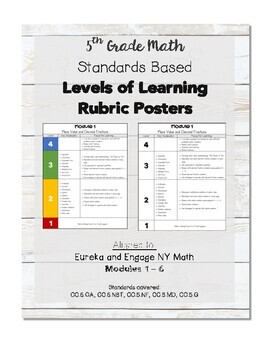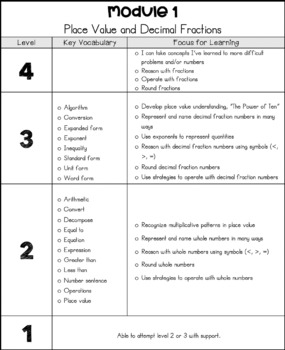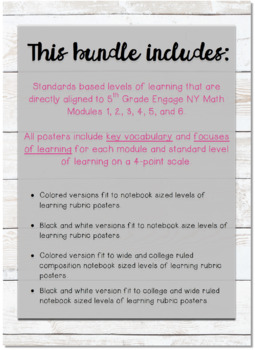5th Grade Math Interactive Notebook Standards Based Scale of Learning Rubrics
Janae Larynn
197 Followers
Grade Levels
5th, Staff
Subjects
Resource Type
Standards
CCSS5.MD.A.1
CCSS5.MD.B.2
CCSS5.MD.C.3
CCSS5.NBT.A.1
CCSS5.NBT.A.2
Formats Included
- PDF
Pages
32 pages
Janae Larynn
197 Followers
Description
5th Grade Mathematics Standards Based Scale of Learning Rubrics Posters for interactive math notebooks. These are aligned to Eureka and Engage NY 5th grade math modules.
I personally use these at the start of each math module and have students glue the math module rubric into their math notebooks. We go over the levels of learning and vocabulary before we start each new module. I also have students circle and date the level they think they are starting out before the module and then at the end of the module circle where they have finished based on the end of module assessment.
Total Pages
32 pages
Answer Key
N/A
Teaching Duration
30 minutes
Report this resource to TPT
Reported resources will be reviewed by our team. Report this resource to let us know if this resource violates TPT’s content guidelines.
Standards
to see state-specific standards (only available in the US).
CCSS5.MD.A.1
Convert among different-sized standard measurement units within a given measurement system (e.g., convert 5 cm to 0.05 m), and use these conversions in solving multi-step, real world problems.
CCSS5.MD.B.2
Make a line plot to display a data set of measurements in fractions of a unit (1/2, 1/4, 1/8). Use operations on fractions for this grade to solve problems involving information presented in line plots. For example, given different measurements of liquid in identical beakers, find the amount of liquid each beaker would contain if the total amount in all the beakers were redistributed equally.
CCSS5.MD.C.3
Recognize volume as an attribute of solid figures and understand concepts of volume measurement.
CCSS5.NBT.A.1
Recognize that in a multi-digit number, a digit in one place represents 10 times as much as it represents in the place to its right and 1/10 of what it represents in the place to its left.
CCSS5.NBT.A.2
Explain patterns in the number of zeros of the product when multiplying a number by powers of 10, and explain patterns in the placement of the decimal point when a decimal is multiplied or divided by a power of 10. Use whole-number exponents to denote powers of 10.





